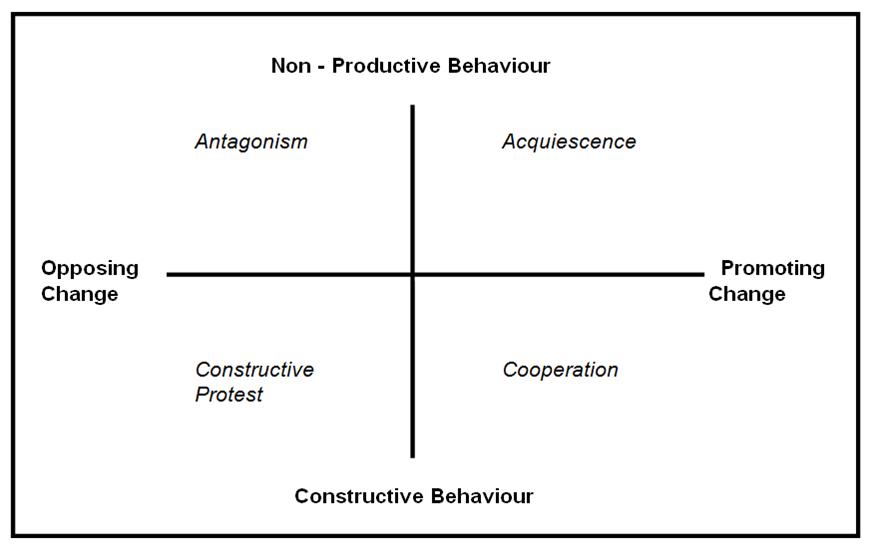“May you live in interesting times” is a Chinese saying often quoted. We recognise that ‘interesting times’ or times of change are difficult and people react in two ways – negative resistors or positive assistors.
This article explores how to deal with negative resistors who can:
- slow down, oppose, inhibit or terminate change processes
- undermine or misdirect efforts
- impede organisational progress in attaining goals or being effective
- destroy an organisation
Defining Resistance
Resistors display counter-productive behaviour. The goal is indiscriminate avoidance of change (as a premature response), when change is perceived to be threatening. Resistance does not have to be prevented or eliminated, as it is often part of the change process.
Benefits of Resistance
Resistance gives you:
- more insight into people and organisational culture
- data about counter-productive dynamics
- signals that you need to know more about
If resistance is managed effectively it can become an asset to the change process. Only un-managed resistance leads to poor outcomes.
Why Don’t We Deal With Resistors?
We often find resistors difficult to deal with because of our:
- Inability to recognise resistor behaviour, as some behaviour occurs in private
- Underestimating the negative influence of resistance
- Lack of skills to effectively manage resistance
- Lack of confidence in applying strategies
Step One in Dealing with Resistance
The first step is to correctly identify the resistor behaviour so the appropriate strategies can be chosen. All attempts to create change depend on the correct interpretation of resistors’ behaviours.
A four quadrant model to more accurately identify responses to change can be seen below.
 The model indicates that not all change-promoting behaviour is constructive, and not all change-opposing behaviour is resistance. The danger is to misread two of the quadrants (Acquiescence and Constructive Protest). Acquiescence can be misread as Cooperation, and Constructive Protest can be misread as Antagonism. The goal of antagonism and acquiescence is to maintain the existing organisational state, which erodes organisational effectiveness. The goal of constructive protest and cooperation is to facilitate re-organisation to achieve outcomes, leading to effectiveness
The model indicates that not all change-promoting behaviour is constructive, and not all change-opposing behaviour is resistance. The danger is to misread two of the quadrants (Acquiescence and Constructive Protest). Acquiescence can be misread as Cooperation, and Constructive Protest can be misread as Antagonism. The goal of antagonism and acquiescence is to maintain the existing organisational state, which erodes organisational effectiveness. The goal of constructive protest and cooperation is to facilitate re-organisation to achieve outcomes, leading to effectiveness
Strategies to Deal with Resistance
After identifying the behaviour correctly, 3 strategies can be implemented:-
- Confront Resistor Inconsistencies
Resistors may send contradictory messages. This makes it difficult to work collaboratively with them. An example is a resistor publicly being enthusiastic for a project yet privately failing to return phone calls, or engage in necessary research. A perceptive leader should press the resistor to acknowledge the “mixed” message, so the resistor can take responsibility for clear communication.
- Reframe Resistors’ Control Issues
Resistors often desire to be in control, which is part of the need to feel secure. So a resistor will see the change process as threatening in the short and long term. A leader needs to address these deep needs of control by using a reframing strategy. This strategy allows leaders to maintain the integrity and self esteem of all those affected.
The reframing strategy requires three actions:-
- Affirm the resistor and give empathy.
Acknowledge and validate the resistor’s fears. Let the resistor know the changes will require adjustment and will probably be uncomfortable during the initial period. Also listen to fears and grievances. Do not overlook, minimise or invalidate resistors’ feelings.
- Redefine the resistor’s notion of control
A leader should not expect a resistor to simply relinquish control. Instead help resistors to understand that while they may be giving up control over local interests they can now be involved in broad scale control (eg creating a vision for the future)
- Invite all members to actively participate in all aspects of the consultation process
Reframing strategy allows resistors to see how redefined roles (shifts in power) are meaningfully linked to organisational goals and have long-term benefits. It gives them a “voice” in the changes by actively involving them in the process.
Conclusion
Leaders should approach resistors with sensitivity, patience and understanding, as resistors are reluctant to give up the security which gave them meaning and stability. Effective leaders correctly identify resistors’ behaviours and use different strategies to create effective change management.

Colin Noyes is the Director of ResourceZone International. He has thirty-five years of ministry experience as a pastor, college lecturer and consultant/coach to consultants, denominational leaders and local church pastors. He can be reached at info@resourcezoneinternational.com
Related Resources




Comment here